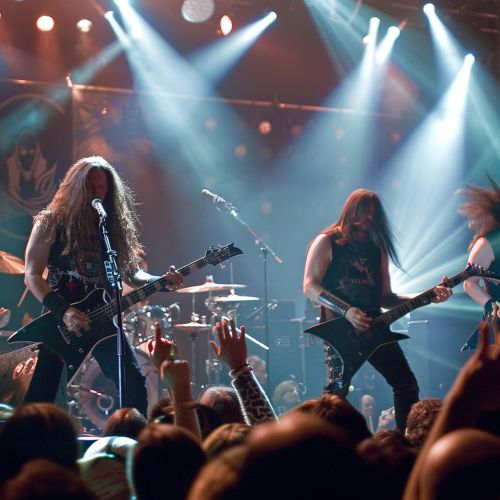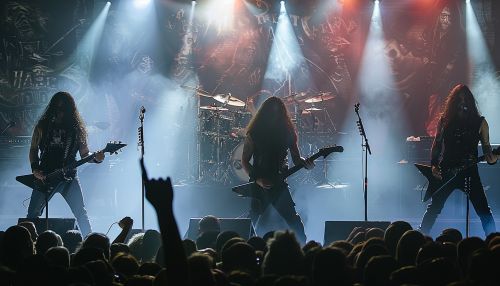Heavy metal (music): Difference between revisions
(Created page with "== Introduction == '''Heavy metal''' is a genre of rock music that developed in the late 1960s and early 1970s, primarily in the United Kingdom and the United States. With roots in blues rock, psychedelic rock, and acid rock, heavy metal bands developed a thick, massive sound characterized by highly amplified distortion, extended guitar solos, emphatic beats, and overall loudness. The lyrics and performance styles are often associated with masculinity, aggression, a...") |
No edit summary |
||
| Line 19: | Line 19: | ||
Heavy metal is known for its use of electric guitars, bass guitars, and drums, often accompanied by powerful vocals. The electric guitar is central to the genre, with guitarists using techniques such as [[palm muting]], [[tremolo picking]], and [[sweep picking]] to create a distinctive sound. Amplification and effects pedals are also crucial, allowing for the high levels of distortion that define the genre. | Heavy metal is known for its use of electric guitars, bass guitars, and drums, often accompanied by powerful vocals. The electric guitar is central to the genre, with guitarists using techniques such as [[palm muting]], [[tremolo picking]], and [[sweep picking]] to create a distinctive sound. Amplification and effects pedals are also crucial, allowing for the high levels of distortion that define the genre. | ||
[[Image:Detail-91459.jpg|thumb|center|Heavy metal concert with a band performing on stage, featuring electric guitars, bass, and drums, with a crowd of fans in the foreground.|class=only_on_mobile]] | |||
[[Image:Detail-91460.jpg|thumb|center|Heavy metal concert with a band performing on stage, featuring electric guitars, bass, and drums, with a crowd of fans in the foreground.|class=only_on_desktop]] | |||
=== Song Structure === | === Song Structure === | ||
Latest revision as of 04:21, 21 June 2024
Introduction
Heavy metal is a genre of rock music that developed in the late 1960s and early 1970s, primarily in the United Kingdom and the United States. With roots in blues rock, psychedelic rock, and acid rock, heavy metal bands developed a thick, massive sound characterized by highly amplified distortion, extended guitar solos, emphatic beats, and overall loudness. The lyrics and performance styles are often associated with masculinity, aggression, and machismo.
Origins and Development
Early Influences
Heavy metal's roots can be traced back to the late 1960s, with bands like Led Zeppelin, Black Sabbath, and Deep Purple often cited as pioneers of the genre. These bands drew heavily from blues rock and psychedelic rock, incorporating heavier guitar riffs and darker themes. The use of power chords, a staple in heavy metal music, can be traced back to these early influences.
The Birth of Heavy Metal
The term "heavy metal" was popularized in the early 1970s, although its exact origin is debated. Some attribute it to the lyrics of Steppenwolf's "Born to Be Wild," while others point to the writings of William S. Burroughs. Regardless, by the early 1970s, bands like Black Sabbath had solidified the genre's characteristics: downtuned guitars, dark and often occult-themed lyrics, and a focus on volume and power.
Musical Characteristics
Instrumentation
Heavy metal is known for its use of electric guitars, bass guitars, and drums, often accompanied by powerful vocals. The electric guitar is central to the genre, with guitarists using techniques such as palm muting, tremolo picking, and sweep picking to create a distinctive sound. Amplification and effects pedals are also crucial, allowing for the high levels of distortion that define the genre.


Song Structure
Heavy metal songs often follow a verse-chorus structure, but they are also known for their complex arrangements and extended instrumental sections. Guitar solos are a hallmark of the genre, showcasing technical proficiency and creativity. The tempo can vary widely, from the slow, doom-laden riffs of doom metal to the breakneck speeds of thrash metal.
Lyrics and Themes
The lyrics of heavy metal songs often explore themes of power, rebellion, and existential angst. Dark and fantastical themes are common, with references to mythology, horror, and the occult. Bands like Iron Maiden and Judas Priest have been known to draw inspiration from literature and history, adding a layer of intellectual depth to their music.
Subgenres and Evolution
New Wave of British Heavy Metal (NWOBHM)
The late 1970s and early 1980s saw the emergence of the New Wave of British Heavy Metal, a movement that revitalized the genre with bands like Iron Maiden, Def Leppard, and Saxon. NWOBHM bands were characterized by their fast tempos, melodic guitar solos, and high-pitched vocals. This period also saw the rise of independent record labels and a DIY ethic among bands.
Thrash Metal
In the early 1980s, thrash metal emerged as a faster, more aggressive subgenre. Bands like Metallica, Slayer, and Megadeth pushed the boundaries of speed and technicality, incorporating elements of hardcore punk and classical music. Thrash metal is known for its complex guitar riffs, rapid drumming, and socially conscious lyrics.
Death Metal and Black Metal
The late 1980s and early 1990s saw the rise of death metal and black metal, two subgenres that took the extremity of heavy metal to new levels. Death metal, with bands like Death and Cannibal Corpse, is characterized by its growled vocals, blast beat drumming, and complex song structures. Black metal, pioneered by bands like Mayhem and Burzum, is known for its lo-fi production, shrieking vocals, and themes of nihilism and anti-religion.
Other Subgenres
Heavy metal has continued to evolve, giving rise to numerous subgenres, each with its own distinct characteristics. Power metal is known for its uplifting, epic themes and virtuosic musicianship. Doom metal focuses on slow tempos and melancholic atmospheres. Nu metal, which gained popularity in the late 1990s, incorporates elements of hip hop and alternative rock.
Cultural Impact
Global Reach
Heavy metal has become a global phenomenon, with thriving scenes in countries as diverse as Brazil, Japan, and Sweden. Each regional scene has its own unique characteristics, influenced by local culture and musical traditions. For example, the Brazilian band Sepultura has incorporated elements of traditional Brazilian music into their sound.
Controversies
The genre has often been the subject of controversy, with critics accusing it of promoting violence, Satanism, and anti-social behavior. High-profile incidents, such as the PMRC hearings in the 1980s, brought heavy metal under scrutiny, leading to debates about censorship and artistic freedom. Despite these controversies, heavy metal has persisted and evolved, maintaining a dedicated fan base.
Academic Studies
Heavy metal has also attracted academic interest, with scholars examining its cultural significance, musical complexity, and social impact. Studies have explored topics such as the genre's representation of masculinity, its use of mythology and folklore, and its role in subcultural identity. The International Society for Metal Music Studies is one organization dedicated to the academic study of heavy metal.
See Also
- Rock music
- Blues rock
- Psychedelic rock
- Thrash metal
- Death metal
- Black metal
- Power metal
- Doom metal
- Nu metal
- Hardcore punk
